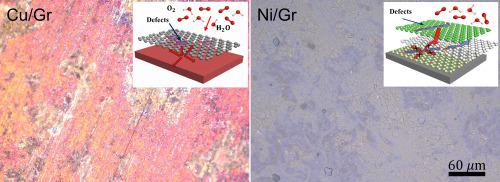Surface & Coatings Technology ( IF 5.3 ) Pub Date : 2020-06-20 , DOI: 10.1016/j.surfcoat.2020.126077 Wei Chang , Pengtao Wang , Yueyang Zhao , Congcong Ren , Branko N. Popov , Chen Li

|
In this study, barrier properties of as-grown graphene layers (Gr) were systematically characterized on two widely used polycrystalline metal substrates, copper (Cu) and nickel (Ni), under ambient humid air as well as in aggressive steam/air environments. Four types of graphene coatings were used to distinguish the bonding effect: directly grown graphene coatings on Cu and Ni as well as transferred graphene coatings on Cu and Ni. Corrosion rates were examined through Tafel analysis in both single-cycle and multiple-cycle experiments. Our study shows that in-plane diffusion of water and oxygen into underlying Cu substrates triggers corrosion of Cu surfaces even in the presence of graphene coatings. Similar corrosion caused by in-plane diffusion of corrosive species was not observed in the Ni/Gr system, which effectively protects the Ni surface in most regions under steam/air environment over 1 month. The Ni/Gr system demonstrates ultra-low and stable corrosion rates compared with those of transferred graphene on Ni (TrGr/Ni) and Cu/Gr systems in destructive corrosion evolution tests. After three cycles cumulative Tafel tests, the corrosion rates of TrGr/Ni and Cu/Gr system dramatically increased 66.3 times and 361.6 times compared to that of Ni/Gr system, respectively. This study shows that the formation of a strong metal-graphene interfacial bond plays a critical role in enabling long-term corrosion-resistant by applying graphene coatings on polycrystalline metal substrates.
中文翻译:

表征沉积在多晶金属上的石墨烯阻挡层的腐蚀性能
在这项研究中,系统生长的石墨烯层(Gr)的阻隔性能在环境潮湿的空气中以及在腐蚀性蒸汽/空气环境中,在两种广泛使用的多晶金属基板上分别被表征为铜(Cu)和镍(Ni)。四种类型的石墨烯涂层用于区分键合效果:在Cu和Ni上直接生长的石墨烯涂层,以及在Cu和Ni上转移的石墨烯涂层。在单循环和多循环实验中均通过Tafel分析检查了腐蚀速率。我们的研究表明,即使存在石墨烯涂层,水和氧气在面内的铜面内扩散也会触发铜表面的腐蚀。在Ni / Gr系统中未观察到由腐蚀物质的面内扩散引起的类似腐蚀,在蒸汽/空气环境下,可以有效保护大多数地区的镍表面1个月以上。在破坏性腐蚀演变测试中,与在Ni(TrGr / Ni)和Cu / Gr系统上转移的石墨烯相比,Ni / Gr系统显示出超低且稳定的腐蚀速率。经过三个周期的Tafel累积试验,与Ni / Gr系统相比,TrGr / Ni和Cu / Gr系统的腐蚀速率分别显着提高了66.3倍和361.6倍。这项研究表明,通过在多晶金属基底上施加石墨烯涂层,形成牢固的金属-石墨烯界面键在实现长期耐腐蚀方面起着关键作用。在破坏性腐蚀演变测试中,与在Ni(TrGr / Ni)和Cu / Gr系统上转移的石墨烯相比,Ni / Gr系统显示出超低且稳定的腐蚀速率。经过三个周期的Tafel累积试验,与Ni / Gr系统相比,TrGr / Ni和Cu / Gr系统的腐蚀速率分别显着提高了66.3倍和361.6倍。这项研究表明,通过在多晶金属基底上涂覆石墨烯涂层,形成牢固的金属-石墨烯界面键对于实现长期耐腐蚀起着至关重要的作用。在破坏性腐蚀演变测试中,与在Ni(TrGr / Ni)和Cu / Gr系统上转移的石墨烯相比,Ni / Gr系统显示出超低且稳定的腐蚀速率。经过三个周期的Tafel累积测试,与Ni / Gr系统相比,TrGr / Ni和Cu / Gr系统的腐蚀速率分别显着提高了66.3倍和361.6倍。这项研究表明,通过在多晶金属基底上施加石墨烯涂层,形成牢固的金属-石墨烯界面键在实现长期耐腐蚀方面起着关键作用。











































 京公网安备 11010802027423号
京公网安备 11010802027423号